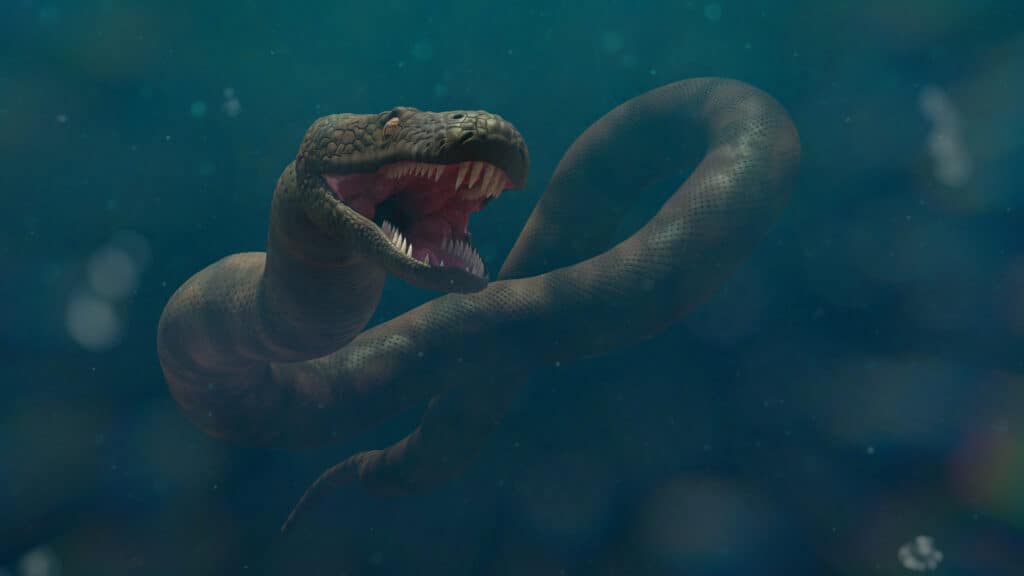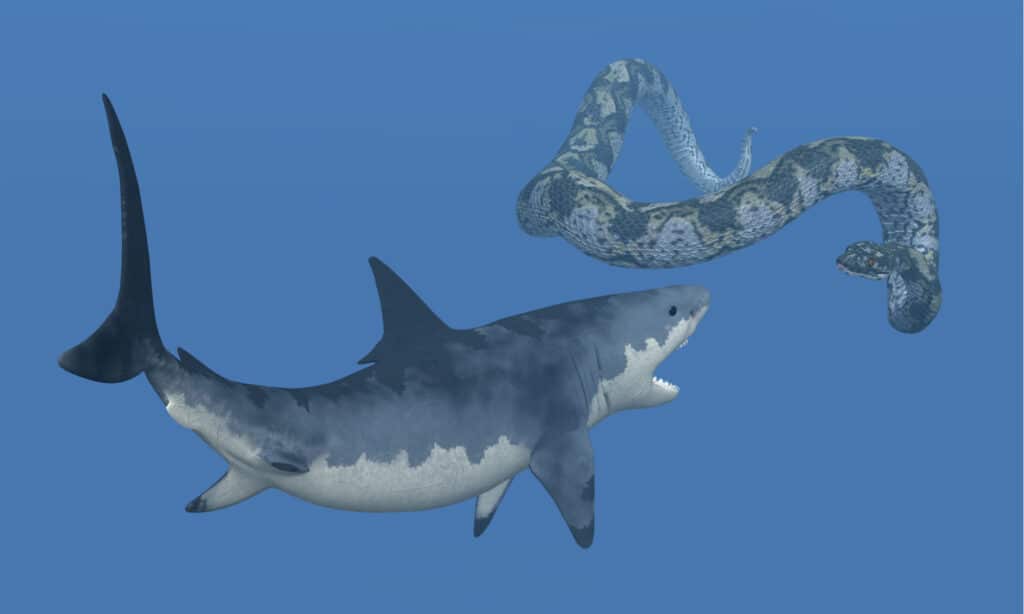There are a lot of large snakes in the world, a few of which have the potential to actually eat humans. Among the largest species out there are the reticulated python (the longest) and the infamous green anaconda (the heaviest).
The anaconda is so famous that movies and tv shows have included them, although many of their cameos are quite exaggerated. Still, it’s wild to consider that a snake has the potential to reach hundreds of pounds and is alive today.
While the anaconda and reticulated python are large, they aren’t the largest snake to have ever lived. In fact, they aren’t even close! Today, we are going to learn about Titanoboa and learn what it took to feed this massive reptile.
Let’s get started!
What is the largest species of snake to ever live?

Titanoboa was the largest species of snake to have ever lived.
©Dotted Yeti/Shutterstock.com
The largest species of snake to have ever lived (that we are aware of) is a specimen named Titanoboa.
Titanoboa wasn’t just big; it was truly gigantic. In fact, the largest snakes alive today absolutely pale in comparison to how large this prehistoric snake was. From the fossil evidence, it’s believed that Titanoboa was between 40 and 50 feet long and weighed over 2,500 lbs. For reference, the largest snakes to have ever been unofficially documented in human history topped out between 200 and 400 lbs. Titanoboa was at least 5 times that.
The first fossils of Titanoboa were discovered around modern-day Columbia, in South America. They lived in the tropical rainforests that existed on the continent, right around 60 million years ago. These snakes came after the time of the dinosaurs, making them some of the largest reptiles on the planet at the time. Researchers have found around 30 fossil elements that confidently belong to Titanoboa, meaning this creature isn’t just some myth that is exaggerated, but an actual creature that lived on earth soon after the dinosaurs were wiped out.
What did Titanoboa eat?

Scientists have discovered parts of the snake’s backbone and skull, which helped them estimate the snake’s massive size.
©Michael Rosskothen/Shutterstock.com
One of the toughest things about being a large apex predator is that finding enough food can be difficult. For warm-blooded mammals, that is even more so the case, although Titanoboa was a cold-blooded reptile. Due to its size, Titanoboa could pretty much eat anything it wanted to, although it likely had a few favorite foods that it was especially evolved to feed on.
Current research points to Titanoboa being piscivorous, meaning it primarily ate fish. During that time period on earth, the prey sources were much larger than most animals are today, and the fossil record backs this fact. While the scientists were digging for fossils in Columbia, where they would eventually find Titanoboa, they also found other animals.
Among these animals were large bony fish, giant turtles, and monstrous crocodiles. All of these large animals would have been the perfect source of food for a hungry snake! After analyzing the data, researchers guess that Titanoboa mostly ate fish, although it would have also eaten other reptiles and amphibians, including large crocodiles and giant turtles.
How did Titanoboa hunt?
They are thought to be expert ambush predators, having the ability to chase and strike their unsuspecting prey at incredible speeds. Their diet included all kinds of giant reptiles, fish, mammals, etc. available for consuming within their habitat.
Extinct Animals
Like many snakes today, Titanoboa was an ambush predator. Essentially, it would sit motionless, sometimes for days, waiting for something to pass close enough to strike. When a turtle or fish would get too close, it would lash out and grab it with its jaws. Like boas today, Titanoboa would then use its immense size and strength to squeeze the prey until it died slowly, a process known as constriction.
Most of a Titanoboa’s life was probably spent in the water. Although it had the ability to go on land, there probably weren’t enough large prey animals to support the snake long-term. Additionally, the immense weight of the snake would have been especially felt while on land. This would have made it uncomfortable and could even be harmful. As a result, it likely stayed in the water whenever possible.
What kinds of fish did Titanoboa eat?

Titanoboa would have eaten large, bony fish and a type of fish known as lungfish.
©Michael Rosskothen/Shutterstock.com
Using data from the fossils and some expert guesses, researchers believe they have an idea of the kinds of fish that Titanoboa mostly ate. From the snake’s bony palate and the number of teeth it had, it probably ate large bony fish and lungfish. Although most of these fish are extinct today, a few species remain, including bone-tongues and mooneyes.
What was the Lifespan of the Titanoboa?
The exact lifespan of the Titanoboa is unknown, as its life span cannot be determined from fossil evidence. However, based on the growth rates of modern snakes, scientists estimate that they could have lived for several decades.
The lifespan of the Titanoboa is still a matter of speculation as the exact method to determine the age of a snake from fossil evidence is still not well established. However, scientists have made some estimates based on the growth rates of modern snakes.
Modern boas and pythons can live for 20-30 years or more in captivity. If the growth rate of Titanoboa was similar to that of these species, then it is possible that it could have lived for several decades. However, without more concrete evidence, this is just speculation.
Another factor that could have influenced the lifespan of Titanoboa is its environment. The warm, humid climate of the Paleocene epoch in South America may have allowed for a longer lifespan compared to other species.
Wrapping it Up
Although the Titanoboa was one of the top predators during its time, evolution repeatedly shows us that apex predators are the first to go during periods of global change. These snakes were cool, but it’s probably a good thing that they don’t exist anymore – humans and Titanoboa probably wouldn’t have gotten along too well. Still, these snakes were truly amazing. Thankfully, we have their much smaller and more docile cousins around today that we can enjoy.
The photo featured at the top of this post is © Dotted Yeti/Shutterstock.com
Discover the "Monster" Snake 5X Bigger than an Anaconda
Every day A-Z Animals sends out some of the most incredible facts in the world from our free newsletter. Want to discover the 10 most beautiful snakes in the world, a "snake island" where you're never more than 3 feet from danger, or a "monster" snake 5X larger than an anaconda? Then sign up right now and you'll start receiving our daily newsletter absolutely free.
Thank you for reading! Have some feedback for us? Contact the AZ Animals editorial team.







